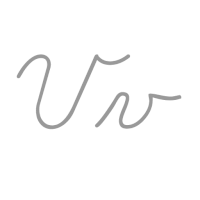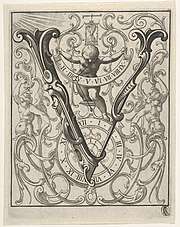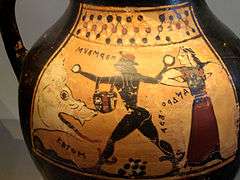V
V or v is the 22nd and fifth-to-last letter in the modern English alphabet and the ISO basic Latin alphabet. Its name in English is vee (pronounced /ˈviː/), plural vees.[1]
| V | |
|---|---|
| V v | |
| (See below) | |
 | |
| Usage | |
| Writing system | Latin script |
| Type | Alphabetic and Logographic |
| Language of origin | Latin language |
| Phonetic usage | [v] [w] [β̞] [f] [b] [u] [ə̃] [y] [ʋ] /viː/ |
| Unicode value | U+0056, U+0076 |
| Alphabetical position | 22 |
| History | |
| Development | |
| Time period | ~-700 to present |
| Descendants | • U • W • ∨ • ℣ • Ꮴ • Ꮙ • Ꮩ |
| Sisters | F Ѵ У Ў Ұ Ү ו و ܘ וּ וֹ ࠅ 𐎆 𐡅 ወ વ ૂ ુ उ |
| Transliteration equivalents | Y, U, W |
| Variations | (See below) |
| Other | |
| Other letters commonly used with | v(x) |
|
History


The letter V comes from the Semitic letter Waw, as do the modern letters F, U, W, and Y.[2] See F for details.
In Greek, the letter upsilon "Υ" was adapted from waw to represent, at first, the vowel [u] as in "moon". This was later fronted to [y], the front rounded vowel spelled "ü" in German.
In Latin, a stemless variant shape of the upsilon was borrowed in early times as V—either directly from the Western Greek alphabet or from the Etruscan alphabet as an intermediary—to represent the same /u/ sound, as well as the consonantal /w/. Thus, num—originally spelled NVM—was pronounced /num/ and via was pronounced [ˈwɪ.a]. From the 1st century AD on, depending on Vulgar Latin dialect, consonantal /w/ developed into /β/ (kept in Spanish), then later to /v/.
During the Late Middle Ages, two minuscule glyphs developed which were both used for sounds including /u/ and modern /v/. The pointed form "v" was written at the beginning of a word, while a rounded form "u" was used in the middle or end, regardless of sound. So whereas "valour" and "excuse" appeared as in modern printing, "have" and "upon" were printed as "haue" and "vpon". The first distinction between the letters "u" and "v" is recorded in a Gothic script from 1386, where "v" preceded "u". By the mid-16th century, the "v" form was used to represent the consonant and "u" the vowel sound, giving us the modern letter "u". Capital and majuscule "U" was not accepted as a distinct letter until many years later.[3]
Letter
In the International Phonetic Alphabet, /v/ represents the voiced labiodental fricative. See Help:IPA.
In English, V is unusual in that it has not traditionally been doubled to indicate a short vowel, the way, for example, P is doubled to indicate the difference between "super" and "supper". However, that is changing with newly coined words, such as savvy "divvy up" and "skivvies". Like J, K, Q, X, and Z, V is not used very frequently in English. It is the sixth least frequently used letter in the English language, with a frequency of about 1.03% in words. V is the only letter that cannot be used to form an English two-letter word in the Australian version of the game of Scrabble.[4] C also cannot be used in the American version.[5]
The letter appears frequently in the Romance languages, where it is the first letter of the second person plural pronoun and (in Italian) the stem of the imperfect form of most verbs.
Name in other languages
- Catalan: ve, pronounced [ˈve]; in dialects that lack contrast between /v/ and /b/, the letter is called ve baixa [ˈbe ˈbajʃə] "low B/V".
- Czech: vé ['vɛː]
- French: vé ['ve]
- German: Vau [ˈfaʊ]
- Italian: vi [ˈvi] or vu [ˈvu]
- Polish: fał ['faw]
- Portuguese: vê [ˈve]
- Spanish: uve [ˈuβe] is recommended, but ve [ˈbe] is traditional. If V is pronounced in the second way, it would have the same pronunciation as the letter B in Spanish (i.e. [ˈbe] after pause or nasal sound, otherwise [ˈβe]);[6] thus further terms are needed to distinguish ve from be. In some countries it is called ve corta, ve baja, ve pequeña, ve chica or ve labiodental.
In Japanese, V is often called "bui" (ブイ), possibly due to the difficulty of typing "vi" (ヴィ or ヸ) or even "vui" (ヴイ), an approximation of the English name which substitutes the voiced bilabial plosive for the voiced labiodental fricative (which does not exist in native Japanese phonology) and differentiates it from "bī" (ビー), the Japanese name of the letter B. Some words are more often spelled with the b equivalent character instead of vu due to the long-time use of the word without it (e.g. "violin" is more often found as baiorin (バイオリン) than as vaiorin (ヴァイオリン)).
Pronunciation and use
| Most common pronunciation: /v/ | ||||
|---|---|---|---|---|
| Language | Dialect(s) | Pronunciation (IPA) | Environment | Notes |
| Alabama | /ə̃/ | |||
| Catalan | Central | /b/ | ||
| Most dialects | /v/ | |||
| Cayuga | /ə̃/ | |||
| Cherokee | /ə̃/ | |||
| Chikasaw | /ə̃/ | |||
| Choctaw | /ə̃/ | |||
| Dutch | Some dialects | /f/ | ||
| Standard | /v/ | |||
| Galician | /b/ | Usually | ||
| /β/ | After vowels, l, or r | |||
| German | Standard | /f/ | ||
| /v/ | ||||
| Irish | /vʲ/ | After i, or before e or i | ||
| /w/ | ||||
| Koasati | /ə̃/ | |||
| Mandarin | Standard | /y/ | Pinyin latinization; informal replacement for <ü> | |
| Mikasuki | /ə̃/ | |||
| Mohawk | /ə̃/ | |||
| Muscogee | /ə̃/ | |||
| Oneida | /ə̃/ | |||
| Onondaga | /ə̃/ | |||
| Seneca | /ə̃/ | |||
| Spanish | /b/ | Usually | ||
| /β/ | After vowels, l, or r | |||
| Tuscarora | /ə̃/ | |||
In most languages which use the Latin alphabet, ⟨v⟩ has a voiced bilabial or labiodental sound. In English, it is a voiced labiodental fricative. In most dialects of Spanish, it is pronounced the same as ⟨b⟩, that is, [b] or [β̞]. In Corsican, it is pronounced [b], [v], [β] or [w], depending on the position in the word and the sentence. In contemporary German, it is pronounced [v] in most loan-words while in native German words, it is always pronounced [f]. In standard Dutch it is traditionally pronounced as [v] but in many regions it is pronounced as [f] in some or all positions.
In Native American languages of North America (mainly Muskhogean and Iroquoian), ⟨v⟩ represents a nasalized central vowel, /ə̃/.
In Chinese Pinyin, while ⟨v⟩ is not used, the letter ⟨v⟩ is used by most input methods to enter letter ⟨ü⟩, which most keyboards lack (Romanised Chinese is a popular method to enter Chinese text). Informal romanizations of Mandarin Chinese use V as a substitute for the close front rounded vowel /y/, properly written ü in pinyin and Wade-Giles.
In Irish, the letter ⟨v⟩ is mostly used in loanwords, such as veidhlín from English violin. However the sound [v] appears naturally in Irish when /b/ (or /m/) is lenited or "softened", represented in the orthography by ⟨bh⟩ (or "mh"), so that bhí is pronounced [vʲiː], an bhean (the woman) is pronounced [ən̪ˠ ˈvʲan̪ˠ], etc. For more information, see Irish phonology.
This letter is not used in the Polish alphabet, where /v/ is spelled with the letter ⟨w⟩ instead, following the convention of German. In German, the letter ⟨v⟩ sounds like /f/.
Other systems
In the 19th century, ⟨v⟩ was sometimes used to transcribe a palatal click, /ǂ/, a function since partly taken over by ⟨ç⟩.
Related characters
Descendants and related letters in the Latin alphabet
- U u : Latin letter U, originally the same letter as V
- W w : Latin letter W, descended from V/U
- Ỽ ỽ : Middle Welsh V
- V with diacritics: Ṽ ṽ Ṿ ṿ Ʋ ʋ ᶌ[7]
- IPA-specific symbols related to V: ⱱ ʋ
- ᶹ : Modifier letter small v with hook is used in phonetic transcription[7]
- Ʌ ʌ ᶺ: Turned v
- ⱴ : V with curl
- Uralic Phonetic Alphabet-specific symbols related to V:[8]
- U+1D20 ᴠ LATIN LETTER SMALL CAPITAL V
- U+1D5B ᵛ MODIFIER LETTER SMALL V
- U+1D65 ᵥ LATIN SUBSCRIPT SMALL LETTER V
- U+2C7D ⱽ MODIFIER LETTER CAPITAL V[9]
Ancestors and siblings in other alphabets
- 𐤅: Semitic letter Waw, from which the following symbols originally derive
- Υ υ : Greek letter Upsilon, from which V derives
Ligatures and abbreviations
- ∨: Logical disjunction
- ℣ : Versicle sign[10]
- Ꝟ ꝟ : Forms of V were used for medieval scribal abbreviations[11]
Computing codes
| Preview | V | v | ||
|---|---|---|---|---|
| Unicode name | LATIN CAPITAL LETTER V | LATIN SMALL LETTER V | ||
| Encodings | decimal | hex | decimal | hex |
| Unicode | 86 | U+0056 | 118 | U+0076 |
| UTF-8 | 86 | 56 | 118 | 76 |
| Numeric character reference | V | V | v | v |
| EBCDIC family | 229 | E5 | 165 | A5 |
| ASCII 1 | 86 | 56 | 118 | 76 |
- 1 Also for encodings based on ASCII, including the DOS, Windows, ISO-8859 and Macintosh families of encodings.
Other representations
V is the symbol for vanadium. It is number 23 on the periodic table. Emerald derives its green coloring from either vanadium or chromium.
v, v., and vs can also be used as an abbreviation for the word versus when between two or more competing items (Ex: Brown v. Board of Education).
| NATO phonetic | Morse code |
| Victor |
 |
|
 |
 |
| Signal flag | Flag semaphore | American manual alphabet (ASL fingerspelling) | Braille dots-1236 Unified English Braille |
See also
- Dominant, in music theory
- Vee
- ∨, logical disjunction
- Check mark
References
- "V", Oxford English Dictionary, 2nd edition (1989); Merriam-Webster's Third New International Dictionary of the English Language, Unabridged (1993); "vee", op. cit.
- "Letter V". Behind the Type. Archived from the original on 20 November 2012. Retrieved 29 October 2014.
- Pflughaupt, Laurent (2008). Letter by Letter: An Alphabetical Miscellany. trans. Gregory Bruhn. Princeton Architectural Press. pp. 123–124. ISBN 978-1-56898-737-8. Archived from the original on 2013-05-10. Retrieved 2009-06-21.
- "2-Letter Words with Definitions". Australian Scrabble® Players Association (ASPA). 8 May 2007. Archived from the original on 5 March 2013. Retrieved 20 February 2013.
- Hasbro staff (2014). "Scrabble word lists:2-Letter Words". Hasbro. Archived from the original on 2014-04-07. Retrieved 11 March 2014.
- Díez Losada, Fernando (2004). La tribuna del idioma (in Spanish). Editorial Tecnologica de CR. p. 176. ISBN 978-9977-66-161-2.
- Constable, Peter (2004-04-19). "L2/04-132 Proposal to add additional phonetic characters to the UCS" (PDF). Archived (PDF) from the original on 2017-10-11. Retrieved 2018-03-24.
- Everson, Michael; et al. (2002-03-20). "L2/02-141: Uralic Phonetic Alphabet characters for the UCS" (PDF). Archived (PDF) from the original on 2018-02-19. Retrieved 2018-03-24.
- Ruppel, Klaas; Rueter, Jack; Kolehmainen, Erkki I. (2006-04-07). "L2/06-215: Proposal for Encoding 3 Additional Characters of the Uralic Phonetic Alphabet" (PDF). Archived (PDF) from the original on 2017-07-06. Retrieved 2018-03-24.
- "Roman Liturgy Fonts containing the response and versicle characters – Roman Liturgy". www.romanliturgy.org. Archived from the original on 2016-07-23. Retrieved 2016-06-24.
- Everson, Michael; Baker, Peter; Emiliano, António; Grammel, Florian; Haugen, Odd Einar; Luft, Diana; Pedro, Susana; Schumacher, Gerd; Stötzner, Andreas (2006-01-30). "L2/06-027: Proposal to add Medievalist characters to the UCS" (PDF). Archived (PDF) from the original on 2018-09-19. Retrieved 2018-03-24.
